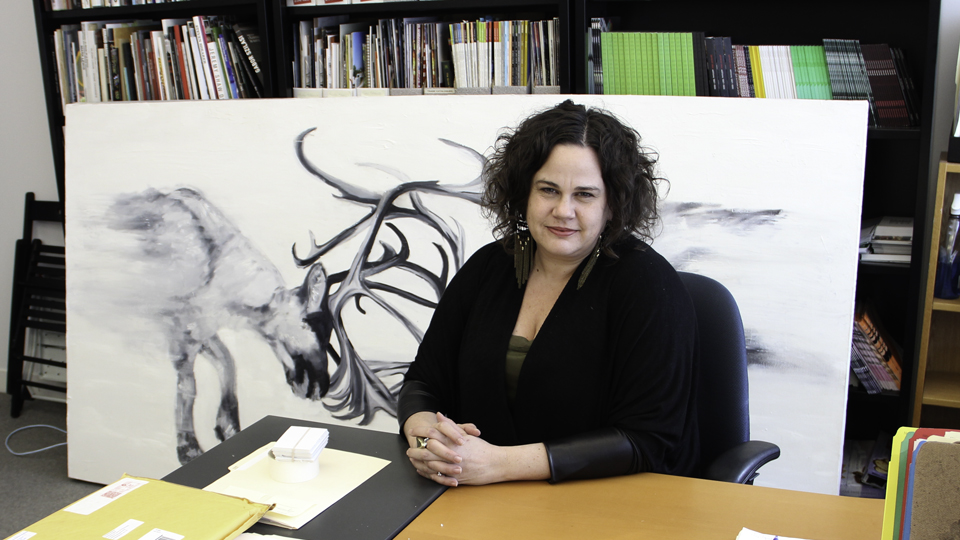The Blackwood Gallery recently welcomed Christine Shaw as its new director and curator, taking over from Christof Migone. Shaw will inevitably bring a new perspective to UTM’s art gallery, and the Medium sat down with her to chat about the direction she plans to take Blackwood in.
The Medium: To start with, could you talk a bit about the path that you took to become the director of the Blackwood Gallery?
Christine Shaw: It’s a path of all kind of diversions and connections, if that makes sense. I started off as a practising artist, so I have a BFA and an MFA in visual arts. I did my MFA at Western University back in the late ’90s, and at the time it was one of the first programs that was really thinking about the intersection between art and theory. So while doing that, I became really interested in the potential of theory and concepts for new kinds of experimentation in contemporary art. I ended up doing a PhD in social and political thought, which was a bit of a digression from visual arts. […]
But what was really interesting to me throughout all of that was looking to informal structures for learning—so not just looking to the university to think about knowledge, but looking at informal networks. I’ve always been engaged in alternative forms of education, as well. Back in the mid-2000s, I co-founded a project called the Toronto School of Creativity and Inquiry, and it was a way of making connections between the academy and the public outside it and [asking], “What could we learn together?” I’m really interested in connecting with non-academics.
TM: What kind of artistic community have you noticed here at UTM, and how do you hope to nurture that or contribute to that with your work at the Blackwood Gallery?
CS: It’s interesting that you ask me that, because it’s not just the artistic community that I’m interested in. I’m interested in all of the different faculties and disciplines across the campus, and how the work at the Blackwood can connect with them. In terms of the artistic community, I think our relationship with Sheridan is really important. I think the kind of work that’s being done at Sheridan is remarkable.
TM: The UTM campus is seeing a lot of population growth and lots of construction around campus. Do you see the Blackwood Gallery growing with that? Do you think it might get a bigger space down the road?
CS: We’d always love to have more space! It’s not in our plans for the very near future, but it’s not a concern for us. […] Something that the Blackwood has been really successful with, especially under the previous director and curator[Christof Migone]—and I intend to continue that trajectory—is creating spaces that aren’t necessarily our Blackwood Gallery in the Kaneff Centre or the e|gallery, but looking across campus or looking across Mississauga. It’s not just about audiences coming to our two spaces, but it’s about our programming going to audiences within and off campus. I think that that’s exciting. So while we want more space, some of the spatial limitations we have provoke us to think about new ways of exhibiting art and new places to do it.
I also think that when cities or campuses are in transition, it raises a whole series of issues about the economy, urban infrastructure, architecture, population, and mobility. Those are issues that we can take up in our programs at the Blackwood. Transition is an interesting problem for us to take on.
TM: As you’ve mentioned, the Blackwood finds a lot of alternative spaces throughout the city, but in terms of the ones actually on campus, how do you see the main Blackwood Gallery space and the e|gallery connecting, and how do you plan to use that e|gallery space?
CS: I think having two spaces is really important, because students are always on the move. So if we entice them into different spaces, that’s really great. […] I’ve been thinking a lot about the connection or non-connection between the two physical spaces. One of the curatorial ideas I’m playing with right now is looking precisely at the path or even the corridor of the CCT Building and the space between the e|gallery and the Blackwood Gallery and [asking], “How might we think about that as a space of transition, not just for people but a transition of an exhibition? How might I use the two galleries to actually transform exhibitions and have parts moving and people thinking about what’s actually happening and unfolding and occurring in both gallery spaces?” Maybe [we’ll] make them pay attention.
TM: Are there any specific perspectives, styles of art, or mediums that you feel haven’t been explored as much as they could be that you’d like to delve into at the Blackwood Gallery?
CS: The Blackwood has been really successful at engaging in all kinds of mediums and practices. There’s a lot of variety, from performance to sound, sculpture, painting, drawing, installation, and kinetic work. So I don’t know if I have much more to bring in terms of the range of disciplinary work within visual arts. I think one thing I’m interested in doing that might deviate a bit from what’s been done before is coming up with and trying to understand some of the shared experiences and shared struggles that can be explored on campus, how we might develop long-term conversation about them.
Another thing I’m really interested in is how to even more actively engage students and faculty in our exhibition program. Not just in terms of how they experience our presentation of art through exhibitions, events, and catalogues, but how might they become involved in the actual construction and development of it? So that’s where some of my strengths in terms of forming collaborations and bringing different people to work together on projects is going to be interesting.



